Backpacking in Minimalist Shoes
You need lots of support from your shoes while backpacking, right? Guess again!
Going Minimal
When I tried my first pair of minimalist shoes 7 years ago, I had no idea how widespread the changes would affect my life. It started with casually wearing Softstar moccasins at home to make my plantar fasciitis go away. Then I began periodically running short distances barefoot with a forefoot strike as an exercise to strengthen my feet. Then next thing I knew, I was training for my first marathon entirely in zero-drop RunAmocs. Before long, I was dumping all my old conventional shoes off at the local thrift store. Softstars replaced most of my footwear needs for athletic, casual and dressy occasions, but Luna’s Mono huaraches also became my go-to summer sandals and I found Lems’ Boulder boots ideal for motorcycle riding. Throughout all these endeavors, I was able to throw away my orthotics and walk without pain for the first time in years.
For some reason, hiking was the one activity that made me hesitant to go minimal. I apparently had an idea hardwired into my brain that I needed lots of “support” on hiking trails, lest my feet pronate or supinate on bumpy ground. Or worse, that I would feel every rock and stick that I stepped upon and that would… be bad? I would do short hikes up to 3–4 miles on easy trails in my RunAmocs, but that was as far as I would push it. That all changed when I came across an article co-written by naturopath Dr. Glen Ingram and podiatrist/Correct Toes inventor Dr. Ray McClanahan.
We posted this article on our blog several years ago, and you can read it here, but the gist of it is this: natural pronation and supination on uneven surfaces are a good thing, as are the sensory perceptions your feet send to your brain when they feel all those rocks and twigs. These actions actually help strengthen your feet and teach your body to adapt to ever-changing ground surfaces, like our ancestors did on a daily basis. Thick and rigid footwear not only prevents the joints in your feet from moving and flexing naturally, but also blocks the groundfeel that sends your brain signals about what you are experiencing.
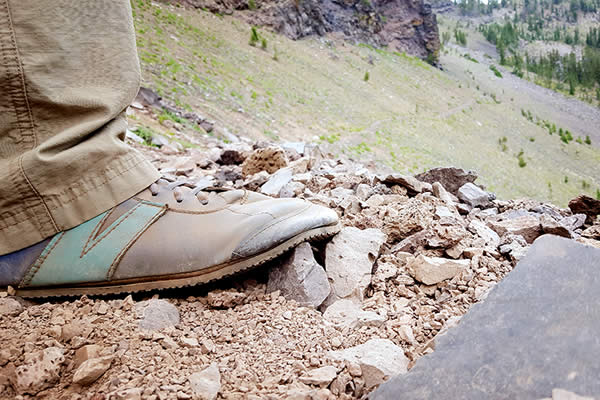
Letting your feet bend and flex naturally over uneven surfaces is a good thing!
Understanding that hiking in minimalist shoes may actually be beneficial, I overcame my hesitation and upped my distances. I should point out that I took a slow, gradual transition to minimalist shoes to strengthen my feet before doing so, but I learned that I could easily hike 10+ miles in one stretch with no problems. My feet were a little sensitive to stepping on all those bumpy objects at first, but after enough exposure and strength training they ended up feeling like a foot massage with every step. My maximum hiking distance for one day is about 18 miles, and even then it is fatigue and whole body soreness that wear me out, not pain from my shoes.
I retained some hesitation, however, with the thought of backpacking in minimalist shoes. A bit of that old mentality of “you need extra support for all that weight” still lingered in the back of my head. I had never been an avid backpacker, but it was something I wanted to experience more. Since I didn’t want to go back to conventional shoes that I knew gave me foot pain I decided to do a little research on the subject.
Zero-Drop Backpacking
It turns out that not only are many folks backpacking in minimalist shoes, but plenty of people are even carrying heavy weight while backpacking entirely barefoot. I found several blogs, forums and podcasts on the subject and learned it wasn't as scary as it seemed. One Softstar customer even sent us a photo of his very well-loved RunAmocs after completing 450 miles of the Appalachian Trail in them! Yes, you need support under a heavy load, but with proper strength training that support can come from your feet, legs and glutes.
This definitely piqued my interest, though I liked the idea of having some protection from the elements so I opted for wearing Softstars rather than barefoot treks into the wilderness. After completing a few ultralight single night backpacking trips with friends over the past couple years, I decided to up the ante and go all out on a solo multi-day adventure last month. This resulted in a trip to eastern Oregon where I spent 5 days on the trails of the Steens Mountains and Strawberry Mountain Wilderness.
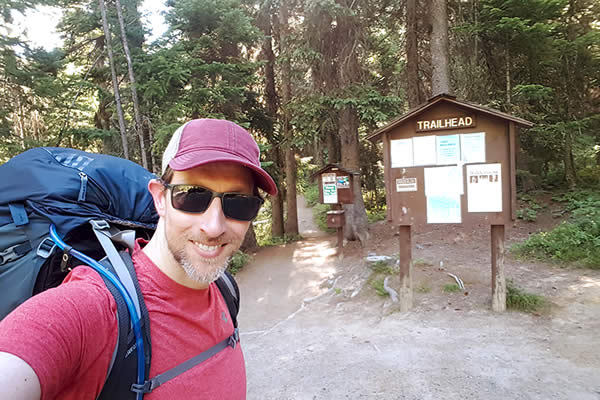
My pack weighed 36 pounds—or as we measure weight at my home, 2 pugs. That isn’t exceptionally heavy, but certainly not ultralight. I took it easy and set a pace of about 8 miles a day. In retrospect I could have done more, but I was in no hurry and didn’t want to risk overdoing it with the given conditions. Temperatures in the Steens were in the high 90s with virtually no shade on the 16-mile Big Indian Gorge trail and that heat took its toll on my stamina. The Strawberry Mountains were cooler with their higher altitude, but also included an elevation gain of 3,285 feet over a 21-mile loop (technically, it was probably closer to 4,000 feet and 24 miles with all the wrong turns I took).
I planned to wear my trusty pair of Oxblood Primal RunAmocs that I tested on my Canadian day hiking adventure last year, but in the end decided to leave them in the truck. They’re still holding up well after one year and hundreds of trail miles later, but I had a shiny new pair of Flint Primal RunAmocs that I had already treated with waterproofing wax and I was eager to get them dirty. The waterproofing turned out to be unnecessary since the weather stayed dry, but I figured it was better to be safe than sorry. In addition, I stuffed my Luna Mono sandals into my pack as camp shoes, which I also threw on for stream crossings.
Aside from my sleeping pad springing a leak on the last two days, the trip went off without a hitch and my feet felt fantastic! I even wore Correct Toes under my shoes the whole time with no discomfort. I use them because years of wearing shoes with tapered toe boxes has given me a neuroma and the pain disappears immediately when I put on the toe spacers. There were many places where I needed to tread across sharp, rocky trails, but they turned out to be a breeze. Occasionally, I’d feel a twinge of pain from misstepping on a pointy stone, but nothing too annoying. Overall, I appreciated the extra sensory feedback from feeling everything under my feet. I believe it improved my stability and helped me feel more confident with my footing as I navigated through more technical sections.
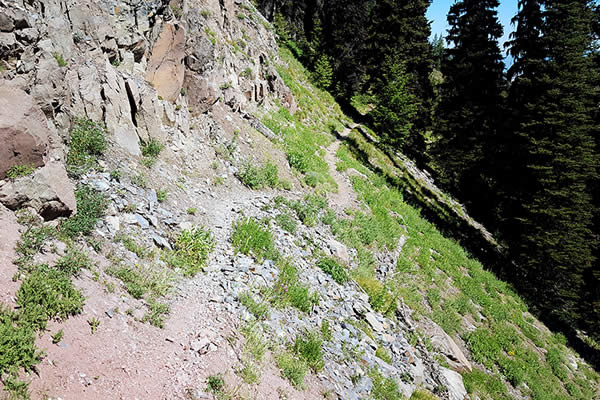
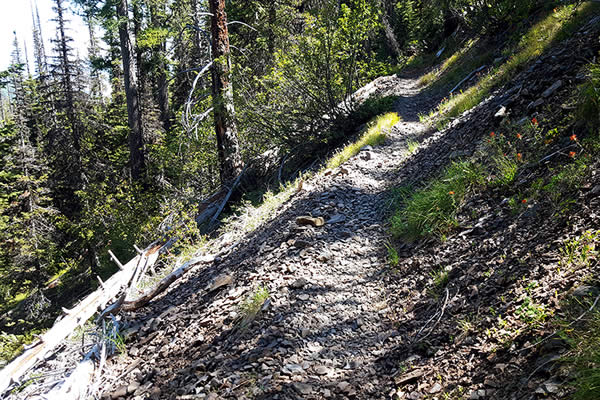
Trails like these used to scare me if I was wearing thin, zero-drop soles. Now they feel like a foot massage!
When I completed the trails I was a little sore all over, and you bet I appreciated kicking off my shoes every night, but my feet were never in pain. I felt comfortable plugging away more miles every day and even followed up the backpacking part of my trip with several day hikes. This included a day exploring the sharp, rugged lava fields of Jordan Craters. And yes, my thin Primal RunAmocs performed well there, too.
In the end, my only regret was putting off this trip for so long. It turned out I had nothing to fear, and I walked away with a better understanding of what it means to be connected to the ground. Perceiving the nuances of natural, uneven textures under your feet adds a whole new element to feeling in touch with the world around you. If your goal is to get away from the rat race and reconnect with nature then I can’t recommend it enough.
Overlooking Strawberry Lake. My new RunAmocs are starting to look well-loved!
Tips
If you are new to backpacking in minimalist shoes and are considering an adventure of your own, then here are a few tips I learned. I’m not delving into general backpacking advice since there is already an abundance of that online, but rather tips specific to backpacking in minimalist shoes:
1. Transition SLOWLY
I mentioned this above, but I can’t reiterate it enough: if you are not accustomed to wearing minimalist shoes then you MUST take the time to transition gradually or you risk an injury that will bring your fun to a grinding halt. Your feet will be using muscles and tendons in ways they haven’t been used before, and they need to be carefully strengthened before taking on a heavy load. Seriously, 99.99% of the time someone complains about getting an injury in minimalist shoes—usually a stress fracture—it’s because they rushed or skipped the transition period. We have a page on the Softstar website that provides guidelines and timetables from medical professionals for a safe transition:
2. Train
Adapting your feet for minimalist shoes is an essential start, but it isn’t enough for serious backpacking. If you plan to carry 30+ pounds of gear over long distances and high elevation changes, then following up your transition with strength training will save you a lot of pain and frustration. This means not only extra foot strengthening, but also whole-body training and posture correction. I would emphasize the importance of strengthening your glutes and, even more importantly, learning to activate your glutes while you walk to prevent strain on your knees.
These are two sources that we recommend checking out to help you get into top shape:
- Whole Body Barefoot by Katy Bowman. One of our favorite books by our favorite biomechanist, chock full of tips for building strong feet and proper whole body alignment. You may also want to check out Katy’s website nutritiousmovement.com as well as her blog, podcast and Youtube videos for a smorgasbord of free advice, including tips for maintaining healthy posture and gait while hiking. Here’s an example of one of Katy’s free videos, in which she shows how to hike uphill and downhill without killing your knees:
- The Cool Impossible by Eric Orton. Eric is the coach who famously trained Christopher MacDougal to run ultramarathons, as documented in the book Born to Run. He’s a proponent of minimalist shoes who has lots of experience training elite endurance athletes to run ridiculously long distances across high elevation changes. While his focus is primarily on runners, his book is a great resource of exercises to strengthen your feet, glutes and surrounding muscles for a variety of activities. It also includes guidelines for endurance training.
In addition to strength training, I highly recommend taking a weighted backpack out on short day hikes before your actual trip to get an idea of the strain you’ll be putting on your body. If you’re working on correcting your alignment then this is will also help build it into a habit. The first time is always the hardest, but a few practice outings separated by rest/recovery days will go a long way to prepare your feet—and your body—for the real thing.
3. Know Your Terrain Before Picking Your Shoes
What kind of trails will you be hiking, and what will the weather be like? Are there stream crossings? Will you be traversing across snowpack? How rocky or technical are the trails? Knowing these details beforehand will help you determine the style of minimalist shoes you’ll want to wear.
Before my trip, I contacted the local forest service to verify that there was no snowpack remaining on the trails I planned to hike to make sure I knew what I was getting into. I also researched trail reviews on sites like alltrails.com and outdoorproject.com so I’d know what to expect from the terrain (if your adventure is in Oregon, William Sullivan’s thorough Oregon hiking guidebooks are a treasure trove of info!). If you learn a trail has difficult technical sections then it may be prudent to first take shorter practice hikes on similar terrain, if possible. I’ve strengthened my feet enough over the years that thin soles on rocky trails are no longer an issue, but it wasn’t that way in the beginning. The more you strengthen your feet and the more you practice rough terrains, the thinner your soles can be without causing pain.
Changing into Luna sandals at a stream. I probably could have just skipped across the rocks here, but there were two more deeper crossings immediately ahead. Plus, sometimes it just feels good to get your feet wet!
For me, the Primal RunAmoc is my #1 hiking and backpacking shoe. Despite testing other Softstar styles and models from other brands, it’s the shoe I always return to. The one drawback is that it is not a water shoe. Although I added a waterproof coating to mine, which was sufficient for rain and light snowpack, it is not a shoe that performs well if completely submersed in water (doesn’t feel good and could cause the leather to stretch more than I like). Some people prefer hiking shoes that double as water shoes for crossing streams, but personally I don’t like the rubbery/sweaty feel that usually comes from these designs. I’d rather spend most of the day blister-free in my cozy, breathable RunAmocs with their suede footbed and just spend a few minutes changing into my Luna sandals at streams, but you may feel differently.
Have you had any backpacking adventures of your own in minimalist shoes? Or are you one of those hardcore barefoot backpackers? If so, then we’d love to hear your story! Feel free to share in the comments below.
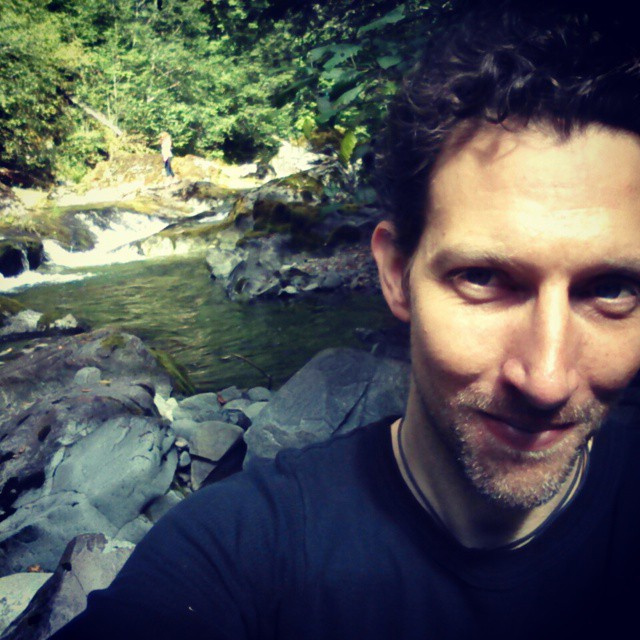
Martin is a lifelong runner who began wearing minimalist shoes over 10 years ago when he found they alleviated his chronic foot pain, which eventually disappeared completely. He further studied proper running form through a series of workshops taught by Correct Toes inventor, Dr. Ray McClanahan DPM. Martin has collaborated with several health care professionals to collect and share peer-reviewed studies that show the benefits of minimalist footwear. In his personal life, Martin loves living in the Pacific Northwest because it allows him to enjoy a variety of outdoor activities year-round, including hiking, cycling, rock climbing, surfing and snowboarding.

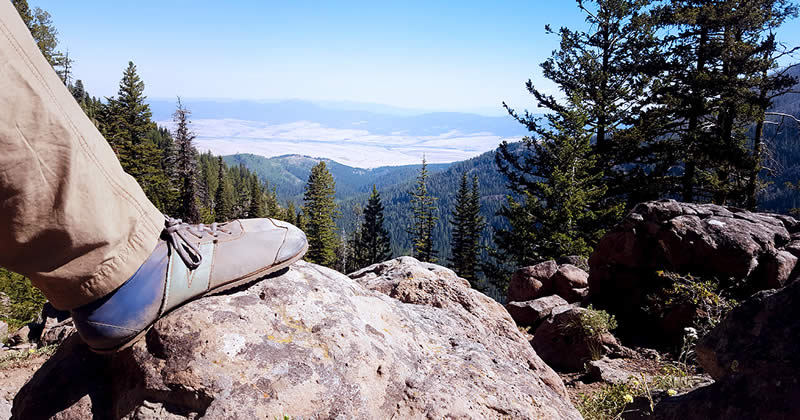



Thanks for the article!
I could use some more thoughts/resource references from you about my recent experience and inquiries. Context: In my day to day casual lifestyle moments (walks, office work, day trips, light to medium gardening) I am 100% using minimalist shoes. My feet are happy with this!
However, I have some extremely rugged lifestyle moments too ( backpacking, professional trail work, farming). In addition, I am transitioning to a new job that will be 75% outside in the Midwest- using tools and bushwhacking in all weather types. I was trying to transition to 100% minimalist shoes in this department too. However, after a backpacking trip on the Olympic National Park Coast- I am thinking twice. I used a pair of minimalist shoes to carry a 40lb pack for three days in muddy/watery/extreme rocky terrain.
My feet are very beat up after this trip. I am disappointed because I love how they feel to the ground/fit generally. But indications show me that for my rugged use- it really isn’t healthy for my foot. I still love them and plan to use them for day use hiking/recreation. However, I simply don’t think they cut it for true rugged use, the seams will bust, not enough support for long rugged use. Another example- using a shovel all day with minimalist footwear- hurts the foot- the bottom of your foot starts to bruise from contact with the metal. I’ve been transitioning to minimalist footwear for two to three years now so it is not new to my feet…
Anyways, any recommendations on references/routes for me? Excersices? Books on minimalist shoe transitioning for rugged use- farming/trailwork? Any brands that are half minimalist? Thoughts on looking for a shoe that provides more cushion underneath the foot, very high waterproof ratings, and super super rugged? Meanwhile, having a open/large toe box and zero drop design? Lastly, I hope this information helps advocate for what might be needed in the minimalist footwear department too- extreme rugged footwear for professional use and all weather types (summer, rain, cold, snow).
Thanks for your time,
Kirsten
I knew Martin when he worked here and must say he had a lot of stamina for staying on his feet all day – I’m right there with you, my feet get sore after wearing thin-soled shoes on a long walk, especially if it’s on a hard flat surface. Our Rogue slip on shoes have a very soft and relatively thick Geo sole, so this would be my choice for light outdoor use, eg, shoveling in the garden or a short hike. They are not waterproof, though. For heavier use, our Switchback boot is a better choice. They are very warm, not completely waterproof, but I’ve personally found them to be waterproof if you are only walking through shallow water and avoid submerging the tongue.
You could check out Upright Health’s video on Youtube comparing the Switchback to the Lems boulder boot: https://www.youtube.com/watch?v=7TVddyRXcXk – his channel also has a lot of videos about exercises for foot, hip and back health. I also highly recommend checking out Katy Bowman’s book “Move Your DNA” because it has great foot exercises illustrations.
Thanks for your comment! We are always trying to improve our products. For example, we have an all-leather version of the Switchback coming out this fall resulting from customer feedback.
Best wishes,
HTM Elf Benjamin